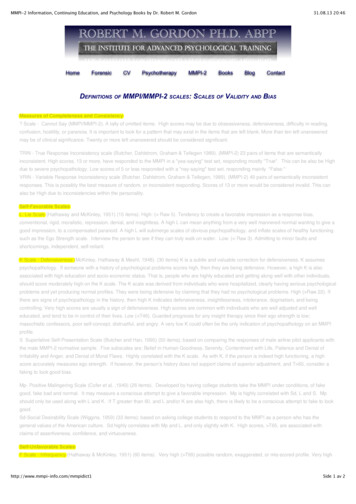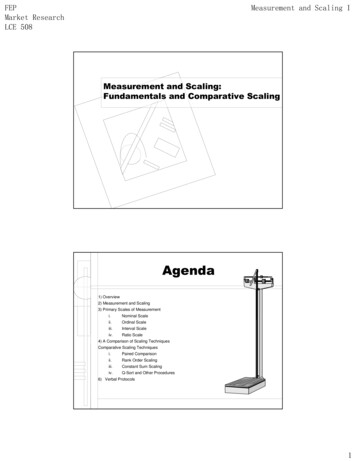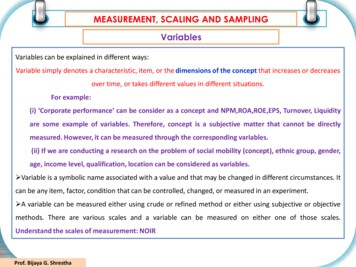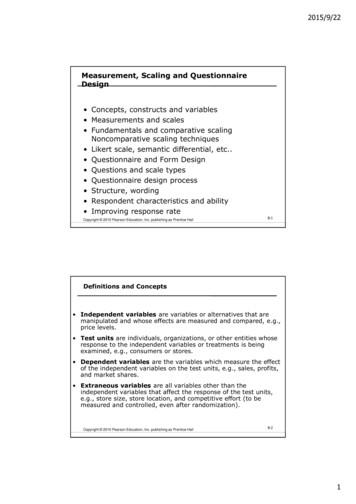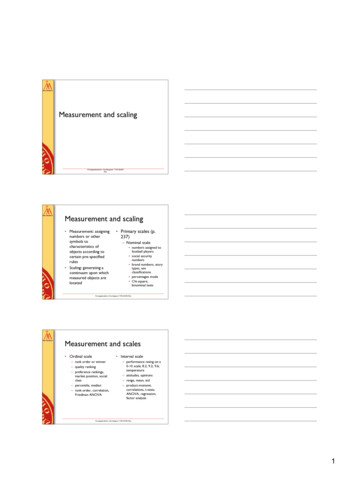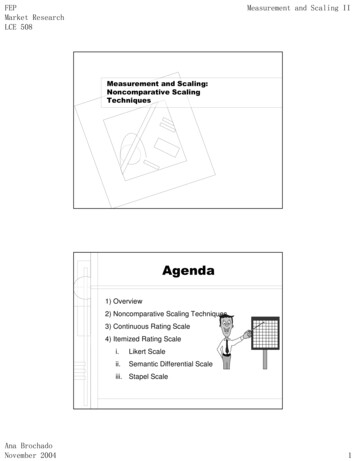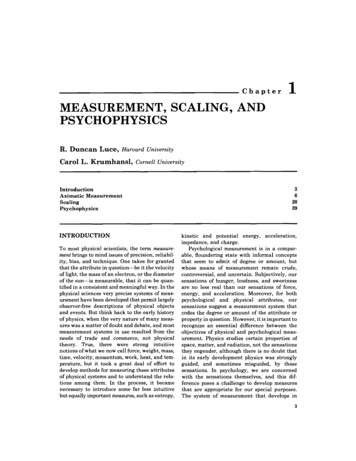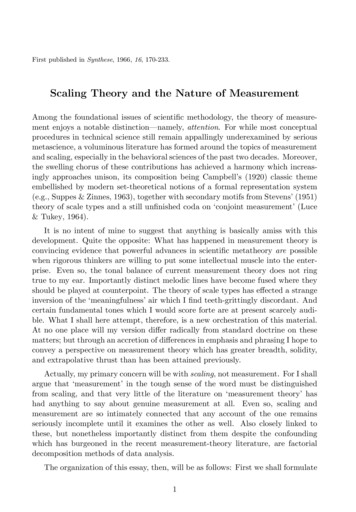
Transcription
Measurement Scales and ScalingDr. Hemal Pandya
Measurement & Scaling Assignment of numbers to characteristics of objects,persons, states or events, according to rules Measurement means assigning numbers or other symbols tocharacteristics of objects according to certain pre-specified rules. One-to-one correspondence between the numbers and thecharacteristics being measured. The rules for assigning numbers should be standardized and applieduniformly. Rules must not change over objects or time.Scaling: Scaling is an extension of measurement. Scaling involves creatinga continuum on which measurements on objects are located.
Importance of measurement research conclusions are only as good as thedata on which they are based observations must be quantifiable in order tosubject them to statistical analysis the dependent variable(s) must be measuredin any quantitative study. the more precise, sensitive the method ofmeasurement, the better.
Keys to Measurement You do not measure the object, person, stateor event, but characteristics of the object Numbers are used to represent theobservable/unobservable characteristics Rules specify how the numbers are to beassigned to the characteristics
Measurement Definitions Concepts: Invented name for theproperty of an object, person, state orevent Construct: A concept, having beendeliberately and consciously invented oradapted for a special scientific purpose–Constitutive Def’n–Operational Def’n
Constructs and Measurement Construct Development Identifying and defining what is to be measured A construct is a hypothetical variable composed ofdifferent elements that are thought to be related (e.g., 5questions tapping brand loyalty) Measurement Figuring out how to measure what you want to measure A Measure needs to be reliable and valid
Components of Measurement M C EM MeasurementC Characteristic being measuredE Errors
The Scaling Process
Primary Scales of MeasurementScales of MeasurementPrimaPrimaryScalesPrimary Scales ofNominalScaleRatioScaleOrdinalScaleIntervalScale
Levels of data NominalOrdinalInterval (Scale in SPSS)Ratio (Scale in SPSS)ratiointervalordinalnominal
Nominal The numbers serve only as labels or tags for identifying andclassifying objects. When used for identification, there is a strict one-to-onecorrespondence between the numbers and the objects. The numbers do not reflect the amount of the characteristicpossessed by the objects. The only permissible operation on the numbers in a nominal scale iscounting. Only a limited number of statistics, all of which are based onfrequency counts, are permissible, e.g., percentages, and mode.Nominal – Categorical Scale exampleWhat is your gender?MaleFemale
Ordinal A ranking scale in which numbers are assigned to objects to indicate the relativeextent to which the objects possess some characteristic. Can determine whether an object has more or less of a characteristic than someother object, but not how much more or less. Any series of numbers can be assigned that preserves the ordered relationshipsbetween the objects. In addition to the counting operation allowable for nominal scale data, ordinalscales permit the use of statistics based on centiles, e.g., percentile, quartile,median.Ordinal Scale Example –Please rank order the following as to how often you recycle each item where 1 itemyou most often recycle, 7 item you recycle the least.CardboardGlassNewspaperPlasticOther Paper ProductsAluminumOther, please specify
Interval Numerically equal distances on the scale represent equal values in the characteristic being measured.It permits comparison of the differences between objects.The location of the zero point is not fixed. Both the zero point and the units of measurement are arbitrary.Any positive linear transformation of the form y a bx will preserve the properties of the scale.It is not meaningful to take ratios of scale values.Statistical techniques that may be used include all of those that can be applied to nominal and ordinaldata in addition the arithmetic mean, standard deviation, and other statistics commonly used in marketingresearch.Interval Scales - it is possible to compare differences in magnitude, but importantly the zero point doesnot have a natural meaning. It captures the properties of nominal and ordinal scales -- used by mostpsychological tests.Designates an equal-interval ordering - The distance between, for example, a 1 and a 2 is the same as thedistance between a 4 and a 5Interval scales:–Size of difference is known–Units are of equal sizeExample - Celsius temperature is an interval variable. It is meaningful to say that 25 degrees Celsius is 3degrees hotter than 22 degrees Celsius, and that 17 degrees Celsius is the same amount hotter (3 degrees)than 14 degrees Celsius. Notice, however, that 0 degrees Celsius does not have a natural meaning. That is,0 degrees Celsius does not mean the absence of heat!
Ratio Possesses all the properties of the nominal, ordinal, and interval scales. It has an absolute zero point. It is meaningful to compute ratios of scale values. Only proportionate transformations of the form y bx, where b is a positiveconstant, are allowed. All statistical techniques can be applied to ratio data.In addition to all the properties of nominal, ordinal, and interval measures, ratiomeasures have a true zero point – Eg. Length of time– Eg. Number of times– Eg. Number of affiliationsCan actually state ratio of one to another– X has twice as many affiliations as YRatio scales:– True zero point exists– Multiplication or division possible
Illustration of Primary Scales of MeasurementTable 8.2NominalScaleOrdinalScaleIntervalScaleNo. StorePreferenceRankingsPreferenceRatings1. Lord & Taylor2. Macy’s3. Kmart4. Rich’s5. J.C. Penney6. Neiman Marcus7. Target8. Saks Fifth Avenue9. 7574675456211-1715171416171514151612RatioScale spent last3 months02000100250350100010
Types of scales Nominal scales--qualitative, not quantitativedistinction (no absolute zero, not equal intervals, notmagnitude) Ordinal scales--ranking individuals (magnitude, butnot equal intervals or absolute zero) Interval scales--scales that have magnitude and equalintervals but not absolute zero Ratio scales--have magnitude, equal intervals, andabsolute zero (so can compute ratios)16
9-17
Primary scales of measurementScaleBasic issiblestatisticsNominalNumbers identify andclassify objects.IdentificationCard, numberingof footballplayers.Brands numbers,store types, sexclassificationPercentages,modeOrdinalNumbers indicate therelative positions of theobjects but not themagnitude of differencesbetween them.Quality rankings,ranking of teamsin a tournamentPreferenceranking, marketposition, socialclassPercentile,medianIntervalDifferences betweenobjects can be compared;zero point is opinions, indexnumbersRange, mean,standarddeviationRatioZero point is fixed; rationsof scale values can becomputedLength, weightAge, income,costs, sales,market shares.Geometricmean (All)Source: Maholtra, N.K. (2004) Marketing Research: An Applied Orientation. Upper-Saddle River, New Jersey, USA: Pearson Education Inc.Measurement and ScalingSlide 18 Associate Professor Dr.Jamil Bojei, 2007
PrimaryScalesofMeasurementTable sticsNumbers identify& classify objectsCommonExamplesSocial Securitynos., numberingof football playersNos. indicate the Quality rankings,relative positions rankings of teamsof objects but not in a tournamentthe magnitude ofdifferencesbetween themDifferencesTemperaturebetween objects (Fahrenheit)Zero point is fixed, Length, weightratios of scalevalues can becomparedMarketingPermissible StatisticsExamplesDescriptiveInferentialBrand nos., store Percentages,Chi-square,typesmodebinomial testPreferencePercentile,rankings, market medianposition, tudes,opinions, indexAge, sales,income, costsProductmomentCoefficient ofvariationRange, mean,standardGeometricmean, harmonicmean
Measurement/Scaling Properties Assignment You can assign objects to categories Order (Magnitude) You can order objects in terms of having more or less of some quality Distance (Equal Intervals) The distance between adjacent points on the scale is identical Origin (Absolute Zero Point) Zero “means something” (absence of a given quality)
Comparison of Measurement ScalesLabel Order Distance OriginNominal scaleYesNoNoNoOrdinal scaleYesYesNoNoInterval scaleYesYesYesNoRatio scaleYesYesYesYes
Another way to describe variables Qualitative variables: have a nominal or ordinalscale of measurement. Continuous variables: have an Ordinal, interval, orratio variables scale of measurement. Quantitative variables: have an interval scale ofmeasurement. Categorical variables: have a nominal or ordinalscale of measurement.
What Type of Scale? Number of Sweaters Purchased This Year? What is Your Ethnicity? To what extent do you agree or disagree that Congress should have approved the 700 bailout? (1 stronglydisagree to 7 strongly agree) Please rank the following issues from most to least important (Iraq, Health Care, Economy, Environment) What is your income? (5-10k; 11-15k; 16-20k; 20-25k; 25-30k) How many hours have you completed toward your degree?under 30 hours30-59 hours60-89 hours90 or more hours
Test Your Knowledge:A professor is interested in the relationship between the numberof times students are absent from class and the letter grade thatstudents receive on the final exam. He records the number ofabsences for each student, as well as the letter grade(A,B,C,D,F) each student earns on the final exam. In thisexample, what is the measurement scale for number ofabsences?a) Nominal b) Ordinalc) Intervald) RatioIn the previous example, what is the measurement scale ofletter grade on the final exam?a) Nominal b) Ordinalc) Intervald) Ratio24
A researcher is interested in studying the effect of roomtemperature in degrees Fahrenheit on productivity of automobileassembly workers. She controls the temperature of the threemanufacturing facilities, such that employees in one facility workin a room temperature of 60 degrees, employees in anotherfacility work in a room temperature of 65 degrees, and the lastgroup works in a room temperature of 70 degrees. Theproductivity of each group is indicated by the number ofautomobiles produced each day. In this example, what is themeasurement scale of room temperature?a) Nominal b) Ordinalc) Intervald)RatioIn the previous example, what is the measurement scale ofproductivity?a) Nominalb) Ordinalc) Intervald) Ratio25
Select the highest appropriate level of measurement:Educational Level:1 Some High school2 High school Diploma3 Undergraduate Degree4 Masters Degree5 Doctorate Degreea) Nominalb) Ordinalc) Intervald) Ratio26
Select the highest appropriate level of measurement:Number of questions asked during a class lecturea) Nominalb) Ordinalc) Intervald) Ratio27
Select the highest level of measurement:Categories on a Likert-type scale measuring attitudes:1 Strongly Disagree2 Disagree3 Neutral4 Agree5 Strongly Agreea) Nominalb) Ordinalc) Intervald) Ratio28
AttitudeAn enduring disposition toconsistently respond in a givenmatterCopyright 2000 Harcourt, Inc. All rights reserved.
Attitudesas Hypothetical Constructs The term hypothetical construct isused to describe a variable that is notdirectly observable, but is measurableby an indirect means such as verbalexpression or overt behavior attitudes are considered to be suchvariables.Copyright 2000 Harcourt, Inc. All rightsreserved.
Three Components of an Attitude Affective Cognitive BehavioralCopyright 2000 Harcourt, Inc. All rightsreserved.
Three Components of AttitudesThe ABCs of attitudes: The Affective Component (based on feelings oroverall evaluation) Feelings of like or dislike The Behavioral Component (likely action towardobject; e.g. from a consumer behavior point ofview, the consumer’s intention to buy a product)Intentions to behave The Cognitive Component (based on beliefs;what you think about a marketing stimulus) –Information possessed
AffectiveThe feelings or emotions toward anobjectCopyright 2000 Harcourt, Inc. All rights reserved.
Behavioral Predisposition to action Intentions Behavioral expectationsCopyright 2000 Harcourt, Inc. All rightsreserved.
CognitiveKnowledge and beliefsCopyright 2000 Harcourt, Inc. All rightsreserved.
Measuring Attitudes RankingRatingSortingChoiceCopyright 2000 Harcourt, Inc. All rightsreserved.Copyright 2000 Harcourt, Inc. All rights reserved.
The Attitude Measuring ProcessRanking - Rank order preferenceRating - Estimates magnitude of a characteristicSorting - Arrange or classify conceptsChoice - Selection of preferred alternativeCopyright 2000 Harcourt, Inc. All rightsreserved.
Ranking tasks require that therespondent rank order a smallnumber of objects in overallperformance on the basis of somecharacteristic or stimulus.Copyright 2000 Harcourt, Inc. All rightsreserved.
Rating asks the respondent to estimatethe magnitude of a characteristic, orquality, that an object possesses. Therespondent’s position on a scale(s) iswhere he or she would rate an object.Copyright 2000 Harcourt, Inc. All rightsreserved.
Sorting might present the respondent withseveral concepts typed on cards and requirethat the respondent arrange the cards into anumber of piles or otherwise classify theconcepts.Copyright 2000 Harcourt, Inc. All rightsreserved.
Choice between two or more alternatives isanother type of attitude measurement - it isassumed that the chosen object is pref
Scaling: Scaling is an extension of measurement. Scaling involves creating a continuum on which measurements on objects are located. Importance of measurement research conclusions are only as good as the data on which they are based observations must be quantifiable in order to subject them to statistical analysis the dependent variable(s) must be measured in any quantitative study .

